I was supposed to leave early Tuesday morning for Messina but it was so dark, cold, and rainy that even the roosters didn’t wake up. So I only got out at 10:30. I took SS113 East along the coast. What a beautiful drive. The coast is more rock and shale than sand; but the surf is high and the small towns lovely. I stopped at Castello Tufa, which has some very nice rock formations and walked to the Torre along a private path. There was no one there so I took my chances. I then drove to San Stefano, a town famous for ceramics, and bought some ceramic souvenirs. The owner of the store was very helpful, giving me his phone number and telling me that he would be happy to show me around the mountain towns above San Stefano.


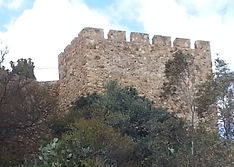
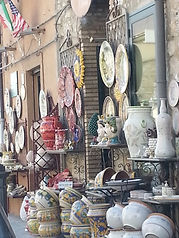

Since I was taking SS113, I drove through many small towns. There are several “resort beaches” along the way; but, I got the sense that they would be frequented by local and not foreign tourists. At least the towns were not mentioned in my guide books. The scenery of the Tyrrhenian Sea and the Islands was spectacular.

I drove through Patti to visit Tindari
and the Tindari Archaeological Park.
Tindari contains a popular pilgramige destination, the Basilica Santuario Maria del Tindari containing the Black Madonna of Tindari, a Byzantine wooden statue originating from the East that portrays a black Madonna. The inscription underneath the icon reads Nigra sum, sed formosa (I am black, but beautiful).
The sanctuary stands in a spectacular position almost 300 meters high on Capo Tindari, its dome glistening in the sun. There is a panoramic view of the entire coast of Patti. The current building stands on the ruins of a pre-existing church destroyed by pirates; it was rebuilt in the 16th century in Baroque style and enlarged in the second part of the 20th century.



I was tired when I got to Angela (my host for 1 night in Milliza) so I took a bath (so nice to have a bathtub rather than a shower) and took a rest. When I woke up Angela and her mother insisted that I have dinner with them. Angela had made rabbit for Easter and insisted that I have some. Her mother kept piling it on my plate and it was delicious. We talked for about an hour about Sicily and Canada and then I went to bed warm and well fed.
Wednesday, It had been very cold Wednesday night (8 C) so I was happy to have central heating and warm blankets. There was new snow on the mountain tops (the Nebrodi). I left early (8:45) after breakfast with Angela, and decided to take the autostrada. It was a terrible drive because there were very many tunnels and the GPS kept losing the signal. The cars were going about 130 km an hour and my eyes didn't adjust fast enough when I entered the tunnels from the bright sunshine.
I wanted to get to the Sacrario "Cristo Re" where my grandfather (Carlo Novati) is buried but it was closed for repairs. I asked if it would be opened at any time soon; but no one could tell me anything. But I walked around the site admiring the view of the harbour and Calabria in the distance.

Sacrario di Cristo Re overlooks Messina from a hill that once was the site of a Roman acropolis and later a Norman castle dedicated to Richard the Lionheart. The neo-baroque structure was built in 1937 as a memorial to WWI casualties. It contains the bodies of about 1,000 soldiers. Next to the church is this 130 tonne bronze bell. It was cast from melted down enemy cannons and it sits on a tower from the ruins of the Roccaguelfonia fortress.
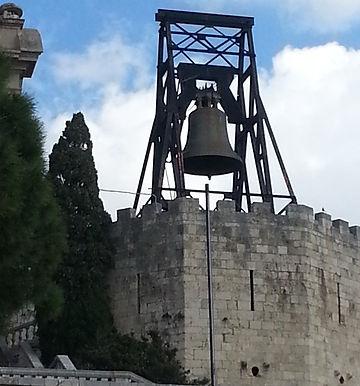
I spent a couple of hours enjoying the sunshine and then went back to Cefalu along SS113, the coastal highway. It took much longer time and there was much traffic through the many small towns with people going home from work. But I enjoyed the view of the sea in the setting sun.

Thursday, I stayed home and relaxed in the garden, caught up in my writing, and having bought packing paper, tape, and a large box, I packed the stuff that I wanted to mail (as well as my winter clothes) to send off. I then went to the post office in Cefalu; but I had difficulty finding a parking spot near the post office. I waited for someone to leave, hoping I did not get a parking ticket. No one left, so I left and will come back another day at a better time.
I had collected a bag full of pine cones at Tindari so I used them to start a wonderful fire in the fireplace. Soon it will be too warm to use the fireplace; but I have been enjoying it on these cooler nights. It is reminding me of home and perhaps that is why I beginning to get very anxious to return.
Friday, I was supposed to go to Palermo but didn’t for several reasons. First, Wind screwed up my recharging of the Tourist Voice and Data Plan. I have to go back and have them fix it. Second, I want to send the books, olive oil, salt, and ceramics (around 20 kg) by mail to Montreal. Not only will the Airline charge me a huge surcharge but I will also have to lug the stuff around. Thirdly (and most importantly) it is a beautiful, warm, sunny day – too nice to spend on a train and in a museum. The beach beacons me. Well, it took over an hour for the Wind agent to contact the sales office and get a refund. I have to go back at 5:00 for him to activate my plan. And I just noticed that Wind only refunded me half the amount they were supposed to. The Post Office was efficient and the package is on its way. I will receive it in Montreal in three weeks.
However, it took me 90 minutes through horrendous traffic to get to the beach. This has helped me make up my mind. I will NOT look for a house near here. Cefalu has been ruined by its success. It is crowded with too many cars, motor cycles for the small streets to handle (even the new parts). The lack of parking also makes it a headache for anyone who wants/needs to shop by car. The pollution from all the vehicles makes the streets stink. There are too many tacky souvenir shops, coffee bars, and frankly, mediocre restaurants. There are many small seaside towns east of Cefalu that are also beautiful without the “tourist cache” and at better prices. I am glad that I am staying up the mountain – at least I can breathe here and enjoy the tranquility, except for the barking dogs.
Lucia, my host in Acireale, had told me about Arabian baths in Cefala Diana so Saturday I decided to drive there to view them. I took E90 along the coast towards Baghera and then south along the SS121 to Cefala Diana, stopping at Altavilla Milicia to take pictures of the view.
As I drove near Cefala Diana, the view was dominated by Castello di Cefalà, a fortification built in the mid-14th century on top of a 657 meter cliff overlooking the road to Palermo. I had to ask some workmen how to find the baths. The roads around Cefala Diana were not well marked, but I eventually found them.
Palms, agave and broom all surround Arab-Norman thermal baths dating from the mid 10th century to the early 11th century and restored in this century. Tubs of warm and cold water alternate, surrounded by stone walls with arabesque windows all topped by an impressive vaulted ceiling studded with round Norman ‘oculi’ for ventilation. The spa is divided into two areas , separated by three pointed arches which are in turn supported by slender, elegant columns, that house basins for washing, walkways and niches to accommodate clothes and linens. Until 1990, the baths were used in summer as actual pools or watering holes and as shelter for the flocks of local shepherds . I was told that they had been closed because of the danger of being scalded. The workmen that were viewing the baths told me that they would be open to the public a few days a week the next year.




I decided to drive to Pollina and Gangi, another mountain town to the East of Cefalu. The sun was shining and you could see the trees “leafing up” and in full flower. They had been in full flower for more than 2 months, unlike in Quebec. The leaves were that wonderful light green. I first took a detour through Sant’ Ambrogio which is perched on a cliff overlooking the sea. It has steep roads winding up the town with views of the sea. Since it is so close to Cefalu it is becoming a tourist destination; however, the town is limiting tourism. There are a few cafes and restaurants but no touristy shops, etc. I will have to come back and take a closer look. I then resumed my drive east along the SS113. What beautiful views of the coast. As you approach the cut-off for Pollina, the seashore gets rockier with these ochre rock formations. You then take the SP25 south up the mountain – what beautiful views and rock formations. At places you can see all the way west past Cefalu and all the way east to beyond the next town, Finale. The mountain scenery is also beautiful with many olive, pear, and vineyards. It is more agricultural than Cefalu although it is still in the Madonai Regional Nature Park.





Pollina is on top of a hill not far from Castelbuono on top of another hill. It has a 16th century Chiesa Madre in the center of the medieval part of town. It used to have a medieval castle on top of the hill but now only the tower remains. Pollina is known for the quality of its spring water which apparantly has a specific taste. People come from the neighbouring towns to collect it.

I then went back down the SP25 and took the SS113 to the next cut off towards Gangi. You immediately pass by the Autostrada with views of the mountains and river. The land is desolate, very few houses but superb views of the mountains. There is much land for sale. I guess the building of the autostrada “forced” people off the land. The houses that are left are derelict – but they must have been grand in their heyday.
The mountain views were spectacular, with large masses of snow-capped mountains. There were also rushing (for Sicily) rivers.
No other cars. There must be many rock and mud slides because the side of the road was lined with big cement panels, some of which had been swept away. In places the road was also washed away.
However, I kept going on smaller and smaller roads –SP60 SP528, SS120, passing through towns not even on the map – Borrello Basso (I guess there is a Borrello Alto), Karsa, Malia. These were all small towns (a few houses). I could see San Mauro Castelverde which is on top of a hill and has views of the Aeolian Islands as well as both the Madonai and Nebrodie Mountains. But instead I took the road to Gangi which became famous because it is offering houses in the medieval center for 1 Euro (and a commitment to restore the house).





Gangi also sits on top of a hill and can be seen for miles. It was also much bigger than I had expected. This put me off so I did not go into Gangi – I will leave it for another day. It is surrounded by snow-capped mountains and agricultural land with farmers clearing the land for the spring planting. The air in Sicily is perfumed with wild flowers, the artemesia that grows everywhere, the pine trees, and today with wood smoke. I drove home and had dinner of fennel and orange salad that Enrico had given me.

The next morning after breakfast in the garden, I decided to explore another road going up the mountains but this time signposted to Ferla. Again, I took the SS113 east and went through Sant’ Ambrogio but followed the signs for Ferla. There was a great road that went up into the mountains (I think it was called via Lancenia). It had lovely rural properties with olive and citrus orchards overlooking the sea. Some were even for sale. As I went up the mountainside, the places got more rural and the views became more spectacular. The problem is that as you take the switchbacks, you lose sight of the sea. There were some fabulous abandoned house (I think) on this mountain on I believe via Carbonara (no road signs). They would be totally tranquil. I even found wild cyclamen. I was completely lost on this mountain only a few kilometers from Cefalu. So I finally headed towards the sea figuring I would find either the autostrada or SS113. Which I did. I was happy to get home to my garden which is now blooming with primroses, irises, and nasturtiums.

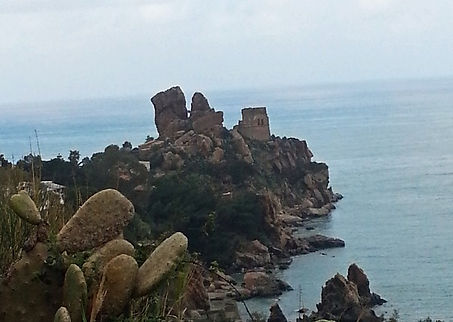


Next morning, I decided to visit Solus (Solunto) built in the 4th century BC by the Greeks, replacing a Phoenician city built in the 6th century BC. It was abandoned by the 3rd century BC and was discovered in 1825. If you would like to know more on Solunto, click here and remember to click on English translation.
Solus or Solunto is located east of Palermo and is a major tourist attraction due to its beautiful location on the Tyrrhenian coast. I spent several hours scrambling over the rock-strewn fields with no one else there. I became very tired and sat down on one of the blocks at the agora, looking at the amazing view, before walking to the "gymnasium", really a private house.



Lastly, I entered the small museum, where many of the artifacts found at Solunto are displayed.
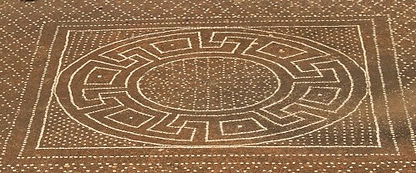


I then drove to Cefalu taking the small roads in the Spring afternoon. I spent an hour at the Cefalu beach before returning to my house for dinner.

The next day, I returned to the medieval village of Caccamo, halfway to Palermo above Termini Imerese overlooking Lago di Rosamarino, Sicily’s largest artificial lake. which is derived from 'caccabe' [horse-heads], may have been given by the Carthaginians who took refuge here after their defeat at Himera in 480 BC. I took the road from TerminiImerse to Caccamo (500 meters above sea level), navigating the steep road with many hairpin turns order to reach the town. After parking, I preceded to the old town to view the narrowest alley in Italy (about 63 centimeters) and the Chiesa Madre, founded in 1090. I then walked to the Castello di Caccamo, the largest and most famous medieval castle in Italy.


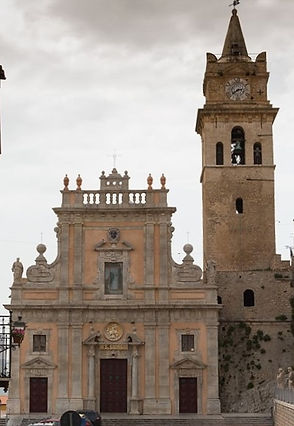
The impressive 12th-century castle is the largest castle in Sicily. It was one of the major Norman strongholds on the island (and never captured). It remained the residence of the dukes of Caccamo until the 20th century. Originally constructed by the Normans in the 11th century, Caccamo's clifftop castle is one of the most dramatically sited in all of Sicily. Beyond the castle's first gate, a ramp leads to a broad courtyard that gives access to the prisons, a chapel, a ragtag arms museum and several monumental, sparsely decorated rooms, from which you can enjoy magnificent views of the surrounding countryside.








The next day, I decided to go to the Piano Sempria within the Rifugio Francesco Crispi to seek the Giant Holly trees (Ilex aquifolium). The refuge was built by the Sicilian Alpine club in 1973. This extraordinary place is composed of more than 100 trees that reach nearly 20m high and are several centuries old. The refuge was closed so I spent several hours hiking on the trails. I was the only person there and it was so peaceful. It was like a crisp fall day in the Laurentians, but more open. I found some wild snapdragons by a fence and a giant holly tree,



The next day, I returned to Palermo by train so I could revisit some of the churches that I had rushed through. I also wanted to buy some coral earrings that I had seen. I passed through the Porto Nuova, built in the 15th century and stopped for a slight snack – it was delicious.



I stayed in Cefalu, packing for my return to Montreal. I spent the day at the beach enjoying an ice cream. Everyone was at the beach enjoying the heat and sunshine. Children were enjoying being in the water. Luigi brought me a gift- plaque he had made with reclaimed copper I will have to send him an art piece I made – a print of a fish.

On the 22nd of April, I loaded the car and left for Catania where I spent the night. I parked the car beside the police station as I didn’t want to empty the car and I didn’t want to be robbed. I walked to the room that I had booked, in the San Berillo district. It was in the older part of Catania in an older building (early 19th century). I walked in and was confronted by a beautiful stairway. My room was on the third floor and I was glad that I didn’t have much luggage. When I got to my room, I immediately took a nap as I was tired by the long drive.
When I woke up, I went for a walk to view the famous Fontana dell'Elefante, through the alleys in the old town. I was surprised by the transvestites sitting outside by the road. They frequently called out to me a friendly greeting so I was grateful for their presence. I hadn't realized my room was in a red light district. In 2019, it was gentrified by artists and now is filled with street art and plants. I wandered around peeking in the streets until it was dusk, I had supper at Caffè del Duomo e Ristorante near the Cathedral of Saint Agatha. I walked back to my car and checked if it was safe and then went to my room and slept.

